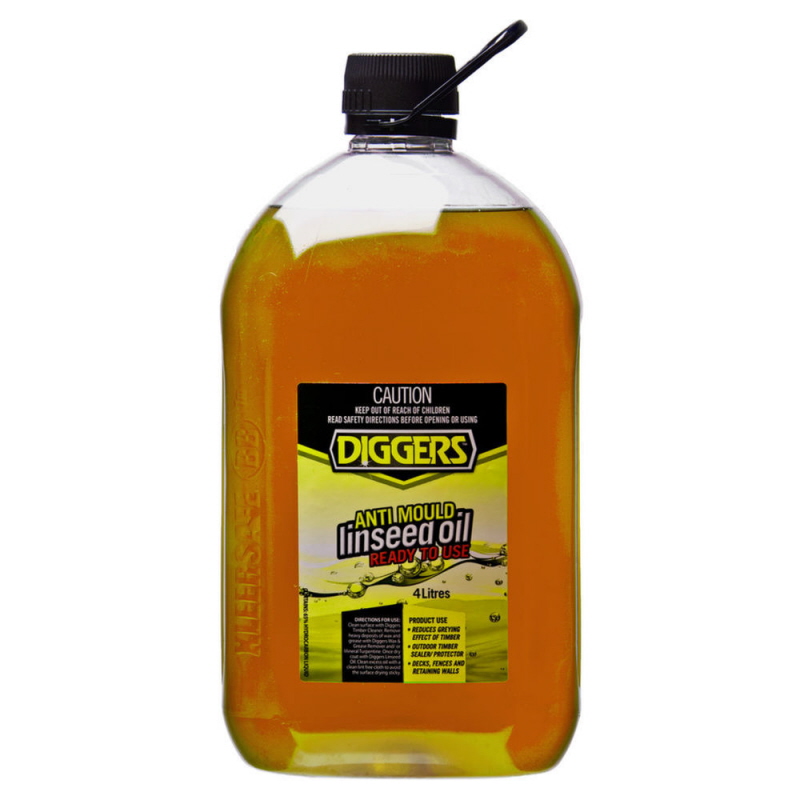Diggers Anti-Mould Linseed Oil 4L
Diggers Anti-Mould Linseed Oil 4L
Typical Uses:
-
Natural oil for decking.
-
Outdoor timber sealer and protector.
-
Decks, fences and retaining walls.
Features:
• Mould, mildew and water resistant.
• Ready to use – no mixing required.
• Reduces the greying effect of timber.
• Coverage: Softwoods/ Hardwoods: 6-8/8-10m² per litre (dependant on porosity and application technique).
• Will produce a warm, golden tone to pine and maple. Porous woods like walnut will darken considerably. Dense cabinet hardwoods will not absorb readily.
• Ready to use – no mixing required.
• Reduces the greying effect of timber.
• Coverage: Softwoods/ Hardwoods: 6-8/8-10m² per litre (dependant on porosity and application technique).
• Will produce a warm, golden tone to pine and maple. Porous woods like walnut will darken considerably. Dense cabinet hardwoods will not absorb readily.
Application:
New Timber
1. Clean surface with Diggers Timber Cleaner. Remove heavy deposits of wax and grease with Diggers Wax & Grease Remover or Diggers Mineral Turpentine.
2. Once dry coat with Diggers Anti-Mould Linseed Oil. Drying time is dependant on weather conditions but as a guideline allow approximately 24 hours between coats. Clean excess oil with a clean lint free cloth to avoid the surface drying sticky.
1. Clean surface with Diggers Timber Cleaner. Remove heavy deposits of wax and grease with Diggers Wax & Grease Remover or Diggers Mineral Turpentine.
2. Once dry coat with Diggers Anti-Mould Linseed Oil. Drying time is dependant on weather conditions but as a guideline allow approximately 24 hours between coats. Clean excess oil with a clean lint free cloth to avoid the surface drying sticky.
Previously Coated/ Weathered Timber
1. Clean and remove previous coating by sanding the surface. Wash and coat as indicated
above.
1. Clean and remove previous coating by sanding the surface. Wash and coat as indicated
above.
How does Linseed Oil work?
When linseed oil is applied to a porous surface it fills the pores and as it is exposed to the
air it gels to form a protective film. The film is generally impervious to water, heat, scratches
and most stains.
When linseed oil is applied to a porous surface it fills the pores and as it is exposed to the
air it gels to form a protective film. The film is generally impervious to water, heat, scratches
and most stains.
NOTE: Timber exposed to the elements will have higher absorption rate.
NOTE: Soak rags in water as spontaneous ignition may occur on drying. Dispose of rags by
controlled incineration or at an approved landfill.
controlled incineration or at an approved landfill.
Safety:
Wear suitable protective clothing, gloves and eye / face protection when using this product.
Frequently Asked Questions:
Q: What is linseed oil and why should I use it?
A: Linseed Oil is natural oil used to seal timber fencing, furniture, tools and sporting equipment.
Linseed Oil is a ‘cost effective’ alternative to expensive timber treatments that doesn’t require
sanding upon reapplication and is generally impervious to water, heat, scratches and most stains.
A: Linseed Oil is natural oil used to seal timber fencing, furniture, tools and sporting equipment.
Linseed Oil is a ‘cost effective’ alternative to expensive timber treatments that doesn’t require
sanding upon reapplication and is generally impervious to water, heat, scratches and most stains.
Q: There are 3 different kinds of Linseed Oil available in the Diggers range – what are the differences?
A: Raw Linseed Oil is 100% natural (raw) linseed oil and requires thinning with mineral turpentine.
Mix at a 50:50 ratio and remove any excess with a lint free cloth.
A: Pale Boiled is ‘Raw Linseed Oil boiled’ with an added ‘drying agent’ that makes it dry faster. It
requires mixing with Mineral Turpentine (50:50) before application. The boiling process removes any
impurities.
A: Anti-Mould Linseed Oil is a ‘Ready to Use’ Linseed Oil that doesn’t require thinning. It has ‘anti-
mould’ additives that help reduce mould growth.
A: Raw Linseed Oil is 100% natural (raw) linseed oil and requires thinning with mineral turpentine.
Mix at a 50:50 ratio and remove any excess with a lint free cloth.
A: Pale Boiled is ‘Raw Linseed Oil boiled’ with an added ‘drying agent’ that makes it dry faster. It
requires mixing with Mineral Turpentine (50:50) before application. The boiling process removes any
impurities.
A: Anti-Mould Linseed Oil is a ‘Ready to Use’ Linseed Oil that doesn’t require thinning. It has ‘anti-
mould’ additives that help reduce mould growth.
Q: Why do I need to add Mineral Turpentine?
A: Mineral Turpentine serves as a ‘vehicle’ that allows Linseed Oil to penetrate deeply into the timber.
When applying oils to timber a better result will be obtained if the oil can penetrate the timber surface.
A: Mineral Turpentine serves as a ‘vehicle’ that allows Linseed Oil to penetrate deeply into the timber.
When applying oils to timber a better result will be obtained if the oil can penetrate the timber surface.
Q: I’ve applied ‘linseed oil’ and it has gone grey – Why?
A: Timber surfaces will grey over time as part of a natural ageing process. The greying effect comes
from mould/ spore growth in the timber grain. Natural timbers with no protection will also fade or change
colour (grey) over time.
A: Timber surfaces will grey over time as part of a natural ageing process. The greying effect comes
from mould/ spore growth in the timber grain. Natural timbers with no protection will also fade or change
colour (grey) over time.
Q: I’ve applied Linseed Oil and it’s gone sticky – Why is this and what can I do?
A: Linseed Oil becoming sticky means that too much has been applied and left to dry before it had a
chance to penetrate the timber surface. Excess oil can present if the timber isn’t absorbing the Linseed
Oil readily and should be removed with a lint free cloth after approximately 20 minutes (this should be
enough time for the Linseed Oil to penetrate the timber adequately). If sticky, use Diggers Lacquer
Thinner and a lint free cloth.
A: Linseed Oil becoming sticky means that too much has been applied and left to dry before it had a
chance to penetrate the timber surface. Excess oil can present if the timber isn’t absorbing the Linseed
Oil readily and should be removed with a lint free cloth after approximately 20 minutes (this should be
enough time for the Linseed Oil to penetrate the timber adequately). If sticky, use Diggers Lacquer
Thinner and a lint free cloth.
Tip: Apply multiple thin coats rather than a single ‘thick’ coat.


